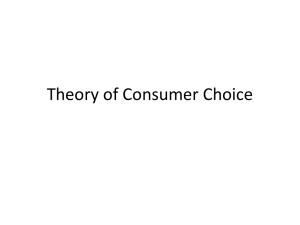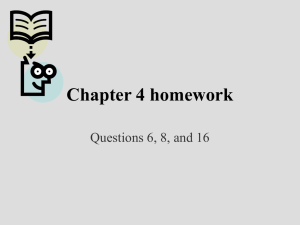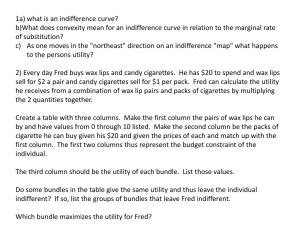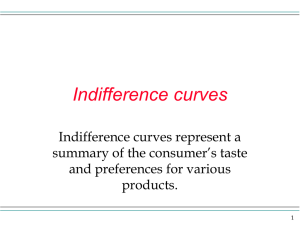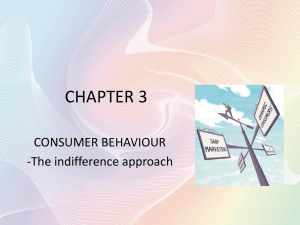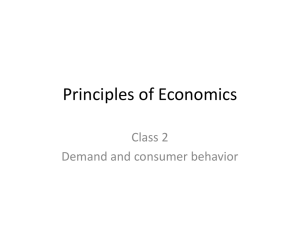x 1
advertisement
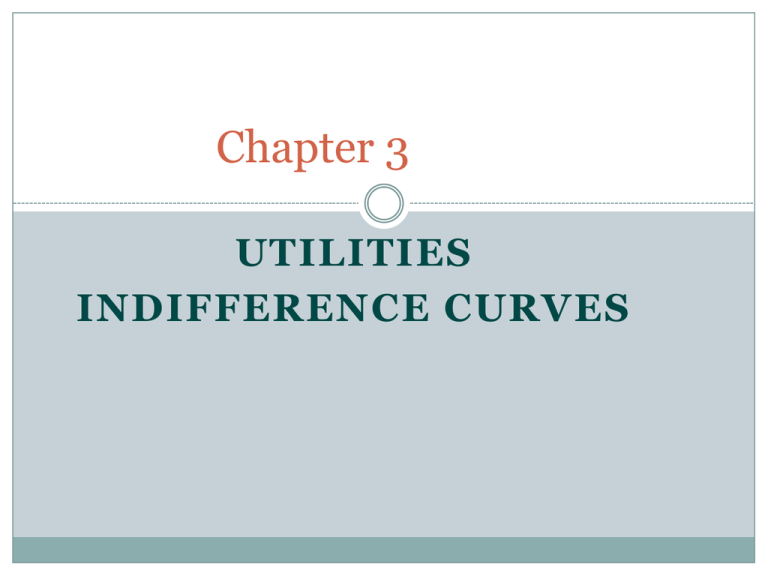
Chapter 3 UTILITIES INDIFFERENCE CURVES Budget line 2 Good 2 150 100 50 Good 1 0 50 100 150 Points on the budget line indicate all the bundles of goods that the consumer can afford. Indifference Curve 3 Indifference curve: locus of bundles that provide the consumer with the same level of satisfaction Indifference curves 4 Good 2 (x 2) a b 20 w 140 100 0 10 Good 1 (x 1) Points on the same indifference curve represent bundles yielding the same amount of utility. Indifference Curves 5 Indifference map Set of indifference curves for a consumer Every bundle On an indifference curve Indifference curves Farther from origin ->Higher utility The Shape of Indifference Curves 6 Indifference curves Cannot slope upward Cannot cross each other Nonsatiation assumption Transitivity and nonsatiation assumptions Farther from the origin – higher utility Nonsatiation assumption Cannot cross each other Are bowed in toward the origin Convexity assumption Farther from the origin - higher utility Indifference curves cannot slope upward 7 Good 2 (x 2) E B x a D 0 y C Good 1 (x 1) If an indifference curve ran from a to x, then bundle x would be no better than bundle a despite containing more of both goods. This upward slope of the indifference curve would be a violation of the nonsatiation assumption. Indifference curves cannot cross each other 8 Good 2 (x 2) a b I1 c I2 Good 1 (x 1) 0 If indifference curves I1 and I2 crossed at a, then by transitivity of preferences bundle b would be no better than bundle c despite containing more of both goods. This crossing of indifference curves would be a violation of the nonsatiation assumption Farther from the origin -> higher utility 9 Good 2 (x 2) a 0 w Bundle w must be preferred to bundle a because it contains more of both goods Good 1 (x 1) Bowed-in (b) (a) 10 Good 2 (x 2) Good 2 (x 2) a a c c b b 0 Good 1 (x 1) (a) Bowed-out indifference curves violate convexity of preferences. Bundle c is a weighted average of bundles a and b, but yields lower utility level because it is on an indifference curve that is closer to the origin. 0 Good 1 (x 1) (b) Bowed-in indifference curves satisfy the convexity of preferences. Bundle c, a weighted average of bundles a and b, yields a higher utility level The Marginal Rate of Substitution 11 Marginal rate of substitution (MRS) Particular point on indifference map One consumer Ratio of exchanging goods Same utility MRS = - ∆x2 / ∆x1 The Marginal Rate of Substitution 12 Diminishing marginal rate of substitution From convexity Move along the indifference curve Same utility level MRS decreases Convex preferences and the MRS 13 Good 2 (x 2) 100 a +∆x2 -∆x1 60 b -∆x1 +∆x2 c 10 9 0 d I1 10 20 100 110 Good 1 (x 1) As the consumer is given bundles containing more and more of good 2, she values an individual unit of good 2 less and less Indifference Curves and Tastes 14 Flat indifference curves Goods that yield no utility Straight-line indifference curves Goods that are perfect substitutes MRS - constant along an indifference curve In a two-good world Indifference curve - straight line (b) (a) 15 Good Good 2 (x 2) 2 (x 2) +∆x2 a 10 9 5 4 0 Good 1 (x 1) (a) Flat indifference curves. The good measured on the horizontal axis is yielding no utility for the consumer. 0 -∆x1 +∆x2 -∆x1 3 8 11 Good 1 (x 1) (b) Straight-line indifference curves: perfect substitutes. The same amount of good 2 is always needed to compensate the consumer for the loss of one unit of good 1. Indifference Curves and Tastes 16 Right-angle indifference curves Goods that are perfect complements Must be consumed in a fixed ratio to produce utility In a two-good world Right angle indifference curves Bowed-out indifference curves Nonconvex preferences (d) (c) 17 Good 2 (x 2) Good 2 (x 2) 11 10 0 +∆x2 +∆x2 -∆x1 b +∆x 2 -∆x1 a -∆x1 b c a 5 6 I1 Good 1 (x 1) 0 Good 1 (x 1) (c) Right-angle indifference curves: (d) Bowed-out indifference curves: perfect complements. Adding any nonconvex preferences and the MRS. As the amount of only one good to bundle a consumer is given bundles containing more yields no additional utility. and more of good 2, he values an individual unit of good 2 more and more. Perfect substitutes 18 Pepsi 0 Coke Mary’s marginal rate of substitution is constant at any bundle of Pepsi and Coke. Optimal Consumption Bundle 19 Optimal consumption bundle Maximize consumer’s utility Within the economically feasible set Best bundle According to consumer’s preferences Characteristics of optimal bundles Indifference curve tangent to budget line Slope of indifference curve = MRS = -∆x2/∆x1 Slope of budget line = price ratio = p1/p2 MRS = p1/p2 The optimal consumption bundle 20 Good 2 (x 2) B x +1 -3 z -4 e k +1 m n F 0 B’ Good 1 (x 1) At the optimal point e, the indifference curve is tangent to the boundary BB’ of the economically feasible consumption set.
